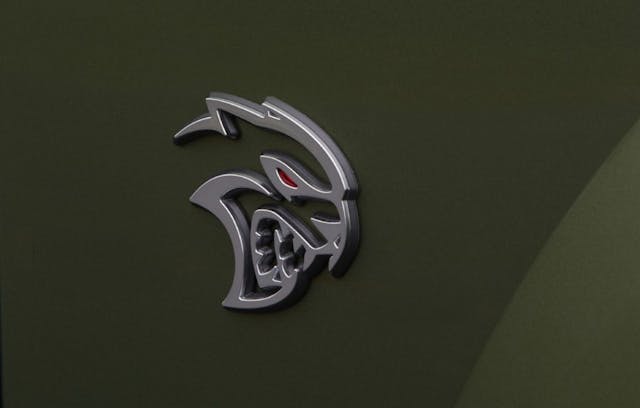Media | Articles
Avoidable Contact #126: How the Hellcat became the only car that matters

The best lack all conviction, while the worst / Are full of passionate intensity. Yeats wrote those lines in 1919, perhaps against the mood of the times. Surely the average citizen in the streets was thrilled at the end of “The Great War,” not quite understanding that the Red October of 1917 and the vicious conditions laid on the submissive Kaiser shortly afterwards would end up reverberating through 70 more years of blood-soaked history everywhere from Auschwitz to My Lai. Yeats was a little more perceptive. He saw past the headlines of the day, past the free-spirited hedonism of what would be called the “Roaring Twenties.” He could see the times to come written in the faces of the men around him. Among the best, and among the worst.
This past week’s announcement that the Hellcats are being discontinued puts me very much in mind of Yeats and his concerns regarding the future. All around us, the automakers around the world are engaged in a humiliating retreat the likes of which we haven’t seen since, uh, August of this year in Afghanistan. In this case, however, there’s no Taliban rushing forward to take pictures with swimming pools and Blackhawk helicopters. Rather, the manufacturers are rushing to kneel before the “EV,” a device which has yet to prove itself more than a toy for rich people and city dwellers. There is no clear pathway to a national EV infrastructure, nor is it clear just where the materials for all of the batteries will be sourced. In any event, the vast majority of the batteries and electric motors will come from China, so this spectacular act of cowardice isn’t just stupid, it’s also suicidal. Should the people who are “on the right side of history” have their way, tomorrow’s automotive market will have the worst of all worlds: Cars will be cheaply built from ecologically catastrophic materials by slave labor in a manner calculated to primarily benefit a Communist dictatorship, but they’ll also be massively expensive and about as long-lived as a BIRD scooter. Good times ahead, I tell you.
This slouching towards a particularly moronic take on Gomorrah could be stopped in a heartbeat if the automakers were helmed by people with courage, vision, and a willingness to work together. They could declare, as a group, that they have no interest in fulfilling any EV mandates, whether state-based or national, and that any governmental entity that published such a mandate would have to figure out a way to keep going on the cars they have now, like Cuba in 2010. We’ve seen this coordinated behavior out of American corporations for any number of social-justice goals in the past few years—but they won’t do it to ensure their own survival. More precisely, they won’t do it to ensure the survival of their employees, because it’s obvious that all the CEOs will receive a golden handshake on the way out the door of whatever EV-policy has to be unwound by their successors once the realities of supply and demand set in. To wit: There’s not enough supply of the batteries, and there’s statistically zero demand for the cars.
How ironic, then, that this repugnant genuflection before an illusory god of perceived future social direction is going to call time on one of the greatest examples in history of giving the customer what he wants—namely, the Chrysler/FCA/Stellantis “Hellcat” engine and the vehicles which it inhabits. In the unlikely event there are any business schools of the future that actually concentrate on doing business rather than “doing good,” surely those schools will teach the Hellcat as a shining example of understanding and responding to the demands of the people who actually pay for the product. In fact, one could argue that the Hellcat series is the greatest modern example of combining first-rate engineering, savvy marketing, and buyer-focused product planning in what we now call “the mobility space.” Along the way, the cars opened up entirely new demographic segments, most notably among African-American and urban buyers. A quick trawl through social media will show you that the Hellcat, in particular a Charger Hellcat Widebody and/or Redeye, is the absolute alpha-dog car in cities from Sacramento to Atlanta.
The Hellcat is such a part of the automotive landscape that it’s hard to believe it originally appeared as a last-ditch attempt to rev-up interest in the aging Dodge Challenger, a full seven model years into that car’s run and 12 years into the lifespan of the platform on which it was built. As they had done with the turbocharged four-banger in the 2003 Neon SRT-4, the Chrysler engineers compensated for a lack of time and budget in the development phase by simply specifying first-rate components from known suppliers wherever possible. This conservatism added some cost to the car but also ensured the Hellcat would build a reputation for reliability despite its stratospheric power rating.
Marketplace
Buy and sell classics with confidence

It’s hard to beat a Hellcat Challenger for raw curb appeal and driving hilarity, particularly when equipped with the six-speed manual, but the real genius was in making a Charger Hellcat. This is the car known around the country as the most desirable platform for “side shows,” rap concerts, and pulling up at the club, to the point that a lot of people outside the narrow band of dedicated automotive enthusiasm aren’t even aware that the Challenger Hellcat exists. “Hellcat” simply means “Charger Hellcat,” and the four-door, 707-horsepower sedan is the star of a thousand YouTube videos, drifting around everything from gas stations to an actual Detroit police cruiser. Social media is packed with accounts like “Hoodville” and “City Boys” that deliver advice like, “If your girl tells you she’s out for the night with her friends and she posts a photo of a Hellcat dashboard … focus on yourself, king, she was never yours, it was just your turn.”
Chrysler marketing and product planning took this unexpected customer response and ran with it hard, hitting the market with a Floyd Mayweather flurry of product variants: Widebody, Redeye, Demon. For the people who wanted most of the show and some of the go, they provided 392 Scat Pack Chargers, Daytona Chargers, and a half-dozen other special editions. The advertising, too, underwent a subtle shift that emphasized the Hellcat’s crossover appeal by showing the car exclusively rather than having people in the picture.
Last but not least, the madmen in product planning actually put the Hellcat engine in … a Grand Cherokee! A Durango! A half-ton 4×4 Ram truck! A former SRT engineer recently told me that “We had no budget, really, and no people to do anything … so we didn’t waste time on corporate stuff or fighting about what could be done. We just did it, as fast as possible. So there’s only a year where we can get the engine in the Durango while passing emissions. Any other company wouldn’t bother … but we did it. Because we could. Because we didn’t have a lot of red tape, and we could ignore half of the red tape that was there.” Along the way, Chrysler completely rewrote a long-understood but rarely-discussed rule of American cars, namely: You can’t have a lot of price spread. Sure, the Germans could get away with having a 320i and an M3 CS, but domestic companies could barely cover the space between Taurus and Taurus SHO. Until, that is, the Hellcat changed everything. It’s possible to buy a Dodge Challenger for $29,680. It’s also possible to buy one for a hundred grand. From a distance, they’ll look alike. But everybody who matters will know what you really have.

How fitting, therefore, that the Hellcat program will end with a “Jailbreak” customization option. It’s the ultimate love letter to Dodge buyers, from Dodge itself, an open acknowledgement that the Hellcat has been the most significant car on the American street for a long time. Yes, a Camaro ZL1 will whip it on a track, and a Shelby GT500 will hurt it everywhere, but those cars are specialty items, targeted at the connoisseurs and fanatics. The Hellcat, on the other hand, is for everyone. It is a sport-utility vehicle at a soccer game, it is a TRX rampaging through the dunes, it is a vinyl-wrapped Charger doing donuts at 1AM with a minor-label rapper in the driver’s seat and a title in someone’s grandmother’s name folded up behind the owner’s manual.
We will miss it when it is gone, when the space filled in the showrooms by these rumbling but perfectly approachable beasts is filled with disposable EV me-too-iguana trash with fake engine noise and a panopticon of LED screens to bully the last bits of our humanity out of our skulls. At that point, the Hellcat will exist only in the garages of wealthy collectors, the junkyards surrounding Atlanta, and the occasional high-dollar auction. It will be as dead and as irrelevant as the Superbird or the LS6 Chevelle. (Cue the angry comments, but you know I’m right. Once a car is worth Superbird money, it’s essentially no longer participating in real life.)
Or maybe not. It’s easy and seductive to imagine a moment like this: You’re sitting in a “mobility-as-a-service-solution” EV transportation unit heading to work, your every pupil flicker monitored by “anti-drunk-driving” devices that enforce your attention like the Voight-Kampff test even as a coalition of ignorant software assistants tugs randomly at your steering wheel with each pothole and shiny spot on the road … and you’ll hear it. In the distance. The roar of an uncorked six-point-two with a milk jug’s worth of blower. The noise will grow louder until it threatens to overcome the mandatory MSNBC audio track in your Shenzhen-built poverty pod … and then you’ll see it. A white Charger Hellcat, swerving through traffic with the imperious disdain of a lion slaying hyenas out of hand. The grill will swell in your rearview camera mirror and then WHOOOSH! it will blast by you. Some young fellow behind the wheel, probably out on bail from his last offense of Driving Without Level 3 Autonomous Assist. For just a moment you’ll have a brief recollection of what it means—what it meant—to be free. And then it will be gone. The drone of approved opinions will resume. Your idiotic car will warn you of an upcoming battery service. The infrared cameras watching your eyes and reporting your retina pattern to the nice people at “Meta” will be temporarily confused. Why is there salt water blocking the cornea? Why is the Primecitizen’s head shaking? Are those … sobs? The time for Yeats is passed then, because we are in full Matthew Arnold mode:
And we are here as on a darkling plain
Swept with confused alarms of struggle and flight,
Where ignorant armies clash by night.
Goodbye, Hellcats. You might have been built in Ontario with a Mexican engine, but you were the best of America.







This is the single most eloquent and heart-felt automotive article I have ever read.